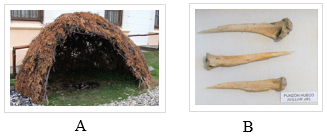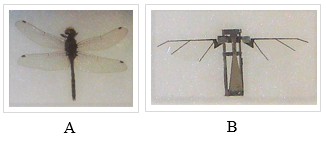MOJ
eISSN: 2576-4519


Short Communication Volume 6 Issue 1
Department of Biomechanics and Sport Engineering, Gdansk University of Physical Education and Sport, Gdansk, Poland
Correspondence: Wlodzimierz S. Erdmann, PhD, DSc., Department of Biomechanics and Sport Engineering, Gdansk University of Physical Education and Sport, Gdansk, Poland, EU
Received: September 05, 2022 | Published: September 20, 2022
Citation: Erdmann WS. Bionics and Biomechanics - how it started and has been developed. MOJ App Bio Biomech. 2022;6(1):26-28. DOI: 10.15406/mojabb.2022.06.00163
BIE, biologically inspired engineering; AFM, atomic force microscopy; TBI, traumatic brain injury
Ancient human beings observed plants and animals that were around them. They thought that when they are dead they can be useful. So, they used natural materials, beyond eating it, to manufacture textiles and tools, to build shelters and huts, and also to use it as weapons. The first natural materials used were fibers of plants and animal skin for clothes, big branches for building of shelters, small branches, large leaves, and hay for covering the roof. Bones were used in many ways. Shells and top part of a scull were used as a kitchen utensil; stomach was used as a container. At the Museo Territorial in Ushuaia (Tierra del Fuego, Patagonia, Argentina) have been gathered many exhibits showing plant and animal materials for early human applications in different areas of life (Figure 1).

Figure 1 Prehistoric utilization of biological materials: (A)-branches of a tree, (B)-bones (Museo Territorial, Ushuaia, Argentina) [Photo: author].
For many centuries basic sciences and also special engineering sciences developed into high level. But merging of biology and engineering has relatively short history. Bionics as biologically inspired engineering (BIE) appeared about 100 years ago (1907) when the first organic material was synthetized, namely bakelite (consisting of wood, phenol and formaldehyde).1 In the 20th century BIE developed enormously. It exists for example in the name of Wyss Institute for Biologically Inspired Engineering at Harvard University (Cambridge, Mass). Some people explain the word bionics as combination of words biology and electronics. Some other scientists and engineers talking on biologically inspired materials and devices use a word biomimetics, e.g. Julian Vincent, director of the Centre for Bio mimetics and Natural Technologies, University of Bath, UK.2
The term bionics was coined by Jack E. Steele in 1958.3 According to Morecki et al.4 development of bionics as a science started in 1960, when the 1st Symposium devoted to bionics was held in Dayton, Ohio, USA.
Today there are plenty of materials and devices based on bionics approach, that are used in engineering, e.g. swimming and flying object (Figure 2) with their hydro- and aerodynamic shape, Velcro material, resilin elastic material, lotus leaf surface, adhesives based on geckos’ feet and many other.

Figure 2 Flying insects: (A)-original, (B)-artificial (Biorobotics Lab, School of Engineering and Applied Sciences, Harvard University) [Photo: author].
Reverse activity to bionics is synthetic biology, i.e. design and assemble biological components using engineering approach. This is especially present in creating new molecules or new arrangements of genes. For example, at Harvard University a subject is taught Biomolecular Engineering and Synthetic Biology.
The first combination of biology and mechanics is also associated with ancient humans. They compared their muscle strength with heavy stones, with branches they needed to break for their needs. They thought on travel distances, time needed to cover it, velocity of movement of animals or other humans in order to run out from predators or to catch slower animals. When the first philosophers, e.g. Aristotle, described the nature they also described its mechanical characteristics. Also, when representatives of Renaissance, e.g. da Vinci, Borelli (Figure 3), introduced their knowledge about the world, especially human body, they presented mechanical phenomena of it.5

Figure 3 Figures from Borelli’s De Motu Animalium (1680); 12-localization of body center of mass, 16-human upper extremity as a lever.5
In the German Lexicon of 1903 a name Biomechanics was introduced (Figure 4).6 The twentieth century was a century of enormous development of biomechanics. In the second half at every developed nation appeared laboratories that were active in research and education on human, animal, and plant body build, forces acting on them, their equilibrium, movement, and interaction with environment. It is applied in everyday living, health, sport, ergonomics, engineering, medicine, aeronautics, astronautics, forensic and other areas. The first international meeting devoted to biomechanics was organized in 1967 in Zurich (Switzerland), the first biomechanics journal (Journal of Biomechanics) has been published since 1968, and the first international organization, namely International Society of Biomechanics was founded in 1973 at the Pennsylvania State University (USA).

Figure 4 Biomechanics (Greek), science on mechanical forces in living organism (Meyers Grossem Konversations Lexikon, 1903).6
For many years within human biomechanics – mechanical body build (Figure 5), muscle mechanics, posture, locomotion, control of behavior, modeling of structure and function of internal organs were the most researched areas. At the beginning of the 21st century new micro-areas have been researched (molecules, cells). Within the Princeton University School of Engineering and Applied Science there is a Department of Chemical and Biological Engineering. Its research areas include: Biomolecular Engineering, Cellular and Tissue Engineering, Complex Materials and Processing, Energy and Environment, Surface Science and Catalysis, Theory of Computation.8 There are several other universities providing specializations devoted to molecular and cell level biomechanics.

Figure 5 Research results of investigating a trunk for modeling of a human body: (A)-image of the trunk as a summation of layers obtained from computer assisted tomography, (B)-trunk parts (thorax, abdomen, pelvis, two shoulders), (C)-internal tissues on the level of umbilicus, (D)-muscle and adipose tissue, (E)-muscle tissue.7
To find the material property on molecular level molecular dynamics was developed. Here, Martin Karplus (France), Michael Levitt (USA), and Arieh Warshel (USA) were awarded Nobel Prize in Chemistry for 2013.
One of the recent developments in finding material properties is atomic force microscopy (AFM). By using piezoelectric sensors it enables obtaining resolution 1000 times better than optical diffraction limit. It takes advantage of the atomic force between the probe and the sample surface. AFM can be applied for measurement of many tiny forces, including adhesion strength, magnetic forces.9,10
At the continuum level there is, e.g. brain damage growth modeling. According to Bakhtiarydavijni et al.11 only in the United States 2.8 million people sustain a traumatic brain injury (TBI) annually. A nanoscale and microscale are needed for cellular damage thresholds to represent localized TBI injury metrics.
There are also several approaches to medical devices. One of them is implantation. Figure 6 shows an example of hip endoprosthesis. Another example is exoskeleton (Figure 7).
Also new integrating field of science and engineering appeared i.e. biomechatronics which aims to integrate biology, mechanics, and electronics.
None.
The author declares no conflicts of interest.

©2022 Erdmann. This is an open access article distributed under the terms of the, which permits unrestricted use, distribution, and build upon your work non-commercially.